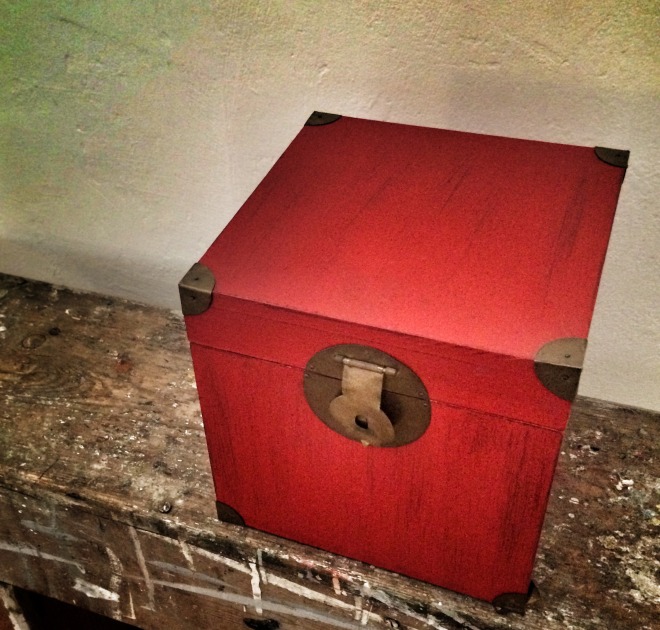This recipe took 20 years to come together from several friends and one ex-lover. It doesn’t take that amount of time or effort to pull together, I promise.

The origins for this recipe starts with this red box. I met Andreas back in the mid 1990s. An ex-boyfriend and now friend, Andreas is a lecturer, aesthete, photographer and poet. Have a look at his site picpoet.net; it combines all his talents in one place and leaves you thirsting for more. Andreas used to write me poetry and leave me notes to find while he was out.
On one of his trips he went home to Greece and brought back this box, filled with dried herbs local to his region. One of these was the Greek classic oregano. Until this point, I’d never come across it, never used it and never realised how much it can transform a simple, classic dish like roast chicken.
What sets this dish apart is its skin. I grew up in house where chicken skin was hit or miss; when it worked, mum’s was the best – crunchy, sticky and morish. When it was bad, it was flabby, oily and usually fed to the dog. The skin part of this dish is thanks to my university friend Natalie whose mum taught her the simple trick you’re going to find here. Try it once and you will never try another way.

Nat and I studied together in Liverpool and shared a house in our final year. Like most students we got little done but had a great time doing it. It was a huge house, on the borders of Toxteth and we shared with Ana (who married Nat’s brother) and an Italian girl called Alessandra. The others who shared that house is a blur – we drank a lot, smoked a lot, partied hard and when we remembered, we studied.
I still smile at the first time I saw Natalie, in our first year when she walked into the seminar with her curly red hair bouncing over a fake fur coat. For a country boy like me, she was the epitome of glam. It’s this image of Nat I hold dear to this day.
The last part of this dish, and for me what really rounds it off are the olives. This addition is a relatively new one and comes thank to Mishi, a dear friend who I met a few years back on a drunken night out with my other half. In a very short time, this short, blonde, cutting edge powerhouse has become a fundamental part of my life. In this time we’ve partied on beaches in Thailand, stayed up all night dancing in the privacy of my living room and cooked up a storm in the kitchen.
Mishi is a chef, and brings her love of life directly into her food and it’s this that earns my love (it’s always about food). On one of her jobs she travelled to Greece and brought back some real Kalamata olives, from Kalamata (who knew?) and it’s their meaty bitterness that makes this dish a smasher.
This is a simple, great dish, 20 years in the making, two hours in the making and about two minutes in the devouring. I hope you have as much fun eating it as I’ve had in pulling it together.
Enjoy
Music to prepare this dish to: ‘The stars line up’ by Marianne Faithfull
Ingredients
- One large chicken
- Dijon mustard (don’t use English or wholegrain)
- One small fresh bunch of Oregano, four stalks should do it
- 75g pitted kalamata olives (in oil or vacuum packed, don’t be tempted by the canned insipid black olives as they add nothing except a rubbery chew)
- 1 large lemon
- 500ml chicken stock
- A generous knob of butter
- Coarse sea salt & pepper
Method
- Pre-heat the oven to 180C (fan).
- Coat the chicken in the mustard and really slather it on and make sure it’s well covered. The flavour will get cooked off so don’t worry about that, but just make sure you do cover it well; if it looks like a lot, then that’s the right amount.
- Place in a heavy-bottomed but not high-side roasting tin and season with salt and pepper.
- Roast for 1hr 45mins to 2 hours depending on the weight of the chook.
- While it’s roasting pick all the leaves off the oregano but don’t chop them.
- Once the chicken is done remove it from the oven and put it on a large serving platter (this is the dish you’ll serve it on) and leave it to rest while you make the gravy.
- Put your roasting tin over a low heat and add the stock. Don’t add all of it – give yourself some leeway as there’s nothing worse than runny/gloopy gravy. I usually add three quarters and build up from there.
- As the stock is heating, scrape all the good bits off the bottom and reduce till you get to your preferred consistency.
- Add the butter and stir through till your sauce goes lovely and glossy. Once it is, decant into a jug.
- Now cut your chicken on the platter. Don’t carve it, use scissors to cut the legs and wings off, then cut the two breasts off, then halve those with the scissors and pile on to your serving platter.
- Scatter the olives over the carved chicken, then your freshly plucked oregano. Add the grated zest of the lemon if you want to.
- At this point pour the gravy over the chicken and squeeze the lemon over the top
- All you need to do is serve and for that you’ll need a spoon to get the gravy from the platter to your plate.

5 Comments